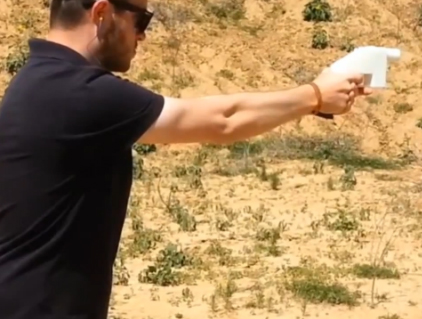
The Liberator,” the world’s first 3D printed firearm. Courtesy of Defense Distributed.”
Latest News
May 8, 2013
Rapid Ready has been covering the idea of building guns and firearm-related peripherals using additive manufacturing (AM) for about as long as it’s been a twinkling in the eye of gun enthusiasts. Defense Distributed has realized its goal of designing, printing and test firing the world’s first 3D printed gun. Plans for the weapon are already available online. This achievement was immediately met with both cheers and boos, depending on which side of the gun control issue people stand on.
The gun rights crowd cheered the success of the “Liberator” as another step forward for freedom. Senator Chuck Schumer isn’t as big a fan. No sooner had the story gone out that the first 3D printed gun would indeed fire, than Sen. Schumer was already proposing a new bill called the Undetectable Firearms Modernization Act, which would make using AM to build firearms illegal.
Before anyone goes off the rails worrying about a stream of 3D printed guns entering the criminal underworld, here are some facts to consider. To begin, the system Defense Distributed used to build the firearm cost $8,000 second-hand. It seems somewhat counter-productive to spend that kind of money on a machine to build guns when real guns can be had for a fraction of the cost, even black market firearms.
The Liberator is pretty much a one-and-done weapon. It holds a single bullet, and after that bullet has been fired, firing a second time is asking for trouble. Plastic is not a happy medium for even low-powered, controlled explosions, and that’s what fires a bullet. With a barrel that looks to be about half an inch long, folks will need to get real close to a target to hit with their single bullet and I doubt the Liberator has the kind of rifling that will assist accuracy.
The capability to build guns at home isn’t a new development. So-called “zip guns” have been around for decades, and they can be built using little more than a rubber band and some wood. A rubber band and some wood are also much, much cheaper in the materials department than the tough plastic required to 3D print a gun. Criminals used zip guns until it became easier to get access to real guns, after which they couldn’t be bothered.
No matter where you stand on the gun debate, maybe you can agree with me on one thing. I sincerely wish folks would put as much time and effort into developing something useful via AM, such as, say, a way to print out solar cells, as they have to making a firearm. People will have a use for cheap energy alternatives far more often than they’ll need a 3D printed gun.
Below you’ll find a video that documents the successful firing of the Liberator 3D printed gun.
Sources: Forbes, New York Observer
Subscribe to our FREE magazine, FREE email newsletters or both!
Latest News
About the Author
John NewmanJohn Newman is a Digital Engineering contributor who focuses on 3D printing. Contact him via [email protected] and read his posts on Rapid Ready Technology.
Follow DE






